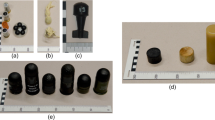Abstract
Although potato cannons are an area of great interest among internet users, they are almost completely unknown in the medical community. These simple ballistic devices are made from plastic plumbing pipes and are powered with propellant gas from aerosol cans. By combustion of the gas–oxygen mixture, a high pressure is produced which propels the potato chunks through the barrel. It is the aim of this study to investigate the hazardous potential of these shooting devices. Test shots were performed using three illegally manufactured potato cannons that were confiscated by police authorities. Velocity, impulse, kinetic energy, and energy density were calculated. The risk of head and chest injuries was investigated by using Sturdivan's Blunt Criterion (BC), an energy based five parametric trauma model assessing the vulnerability to blunt weapons, projectile impacts, and behind-body-armor exposures. The probability of lethality due to blunt impact trauma to the chest was assessed using Sturdivan's lethality model. For potential head impacts, all test shots far exceeded the critical BC (head) value which corresponds to a 50% risk of skull fracture. The risk of injury with regard to chest impacts was similar. All but two test shots far exceeded the critical BC (chest) value corresponding to a 50% risk of sustaining a thoracic skeletal injury of Abbreviated Injury Scale 2 or 3. The probability of a lethal injury due to blunt chest impact was as high as 20%. To conclude, this work demonstrates that potato cannons should be considered dangerous weapons rather than as toys used by adventurous adolescents.


Similar content being viewed by others
References
Gurstelle W (2001) Backyard ballistics. Chicago Review Press, Chicago
Bureau of Alcohol, Tobacco, Firearms, and Explosives (ATF). US Department of Justice Web site. http://www.atf.gov/firearms/faq/unlicensed-persons.html#potato-gun-classification. Accessed 13 November 2010
Barker-Griffith AE, Streeten BW, Abraham JL, Schaefer DP, Norton SW (1998) Potato gun ocular injury. Ophthalmology 105:535–538
Skavysh A, Wojcik R, Murphy RX, Kazahaya M, Pasquale MD, Barraco RD (2007) Facial injuries by potato gun: spuds as scuds. Inj Extra 38:81–83
Franke E (1981) Ermittlung der Bewegungsenergie der Geschosse. In: Zobel KF (ed) PTB-Bericht W-19 Gesetzliche Munitionsprüfung. Physikalisch-Technische Bundesanstalt, Braunschweig und Berlin, pp 27–31
Sellier K, Kneubuehl BP (1994) Wound ballistics and the scientific background. Elsevier Science B.V, Amsterdam
Sturdivan LM, Viano DC, Champion HR (2004) Analysis of injury criteria to assess chest and abdominal injury risks in blunt ballistic impacts. J Trauma 56:651–663
Frank M, Bockholdt B, Peters D, Lange J, Grossjohann R, Ekkernkamp A, Hinz P (2010) Blunt Criterion trauma model for head and chest injury risk assessment of cal. 380 R and cal. 22 long blank cartridge actuated gundog retrieval devices. Forensic Sci Int. doi:10.1016/j.forsciint.2010.10.023
Pignolet F, Guillion F, Duval-Beaupere G, Guezard B, Tarriere C (1990) In vivo measurement of human weight supported by the successive anatomical level from C4 to the femoral head, SAE (Society of Automotive Engineers) Technical Paper 902306 13-21
Lynnerup N (2001) Cranial thickness in relation to age, sex and general body build in a Danish forensic sample. Forensic Sci Int 117:45–51
Hatipoglu HG, Ozcan HN, Hatipoglu US, Yuksel E (2008) Age, sex and body mass index in relation to calvarial diploe thickness and craniometric data on MRI. Forensic Sci Int 182:46–51
Tilotta F, Richard F, Glaunes J, Berar M, Gey S, Verdeille S, Rozenholc Y, Gaudy JF (2009) Construction and analysis of a head CT-scan database for craniofacial reconstruction. Forensic Sci Int 191:e111–e112
Bir C, Viano DC (2004) Design and injury assessment criteria for blunt ballistic impacts. J Trauma 57:1218–1224
Bir C, Viano D, King A (2004) Development of biomechanical response corridors of the thorax to blunt ballistic impacts. J Biomech 37:73–79
Hoxha S, Elliott JE (1985) Simulation of area weapons effects (SAWE) safety criteria. US Army Armament Research and Development Center, Dover
Kneubuehl BP, Coupland RM, Rothschild MA, Thali MJ (2008) Wundballistik. Grundlagen und Anwendungen. Springer, Heidelberg
Mungan CE (2009) Internal ballistics of a pneumatic potato cannon. Eur J Phys 30:453–457
Ayars E, Buchholtz L (2004) Analysis of the vacuum cannon. Am J Phys 72:961–963
Gorrin NR, Moore TC, Asch MJ (1990) Glass shrapnel injuries to children resulting from “dry ice bomb” explosions: a report of three cases. J Pediatr Surg 25:296
European chemical Substances Information System (2000) IUCLID Chemical Data Sheet Butane. http://ecb.jrc.ec.europa.eu/esis/index.php?LANG=de&GENRE=CASNO&ENTREE=106-97-8. Accessed 13 November 2010.
European chemical Substances Information System (2000) IUCLID Chemical Data Sheet Propane. http://ecb.jrc.ec.europa.eu/esis/index.php?LANG=de&GENRE=CASNO&ENTREE=74-98-6. Accessed 13 November 2000.
Pierson HM, Price D (2005) The potato cannon. Determination of combustion principles for engineering freshmen. Chem Eng Ed 39:156–159
Raymond D, Van Ee C, Crawford G, Bir C (2009) Tolerance of the skull to blunt ballistic temporo-parietal impact. J Biomech 42:2479–2485
de Freminville H, Prat N, Rongieras F, Voiglio EJ (2010) Less-lethal hybrid ammunition wounds: a forensic assessment introducing bullet-skin-bone entity. J Forensic Sci. doi:10.1111/j.1556-4029.2010.01431.x
Courtney M, Courtney A (2007) Acoustic measurement of potato cannon velocity. Phys Teach 45:496–497
Conflict of interest
The authors declare that they have no conflict of interest.
Author information
Authors and Affiliations
Corresponding author
Additional information
Ethical standards
Ethical approval was not required for this experimental investigation.
Rights and permissions
About this article
Cite this article
Frank, M., Jobski, O., Bockholdt, B. et al. When backyard fun turns to trauma: risk assessment of blunt ballistic impact trauma due to potato cannons. Int J Legal Med 126, 13–18 (2012). https://doi.org/10.1007/s00414-011-0552-y
Received:
Accepted:
Published:
Issue Date:
DOI: https://doi.org/10.1007/s00414-011-0552-y




